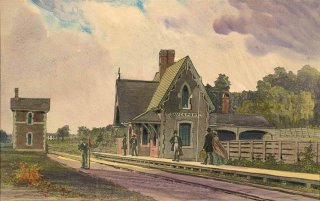
In the 1850s, railroads were becoming popular in America. The railroad had presented itself as a reliable, efficient, and (relatively) cheap way of transporting goods. Canals had become too expensive; not to mention that almost all the commercially feasible canal routes already had canals by the mid 1840s. Roads were unthinkable as an economical way of moving things. (Remember, they didn’t have trucks) Thus, railroad building became popular in the 1850s.
Much of the financing for railroads was done by local, state, and federal governments. These were ted by people who were developing sectional tendencies to tie the Northeast to the Midwest. These officials wanted to keep the Northeast’s old nce in the Union. They feared that the Midwest would be tied to the South, since much of the Midwest is drained by the Mississippi River. So, the New England big-whigs made a massive effort to make the Great Lakes the major outlet of Midwestern goods. First, they made the Cumberland Road, tying Baltimore, Maryland to the Ohio River. That didn’t catch on too well, so they tried the Erie Canal, tying the Hudson River to Lake Erie. That was a great success, so some people in Pennsylvania thought they’d try it. They built a canal from Philadelphia to Pittsburgh. Now wait a second, anyone who has driven across Pennsylvania on I-80, or has taken basic U.S. geography knows that Pennsylvania is not the flattest place in the world. As you probably thought, the “Main Line” wasn’t a huge success.
So, in comes the railroad. Once government officials saw the possibilities of railroads, they jumped on the bandwagon without thinking for another second. Governments on all levels went into debt in their financing of railroads from everywhere to somewhere else. Philadelphia went into a debt of $8 million (which was a lot back then, believe it or not) for the construction of railroads. Ohio passed a law requiring the state to supply one-third of the capital for any new railroad project in the state. And so on and so on. Pretty soon, railroads criss-crossed the Midwest, bringing the region’s produce to the Great Lakes, New England, and the Mississippi. (But mostly the former two)
The North was now tied together firmly. But the South hadn’t been as eager as the North in railroad building. The South didn’t have a very pressing need for construction of railroads. Nor was there any political motive to do so. Besides, any extra capital in the South was more likely to be spent on land or slaves than machinery or ultra-ambitious projects. The ideal life for the Southern man was to get a solid plantation and settle down as a Southern gentleman.
As I mentioned before, the Northern governments financed a large portion of the companies that built railroads there. They did this because they were focused on trying to link West and East together. Thus most of the roads were built with their endpoints at the Great Lakes or ultimately an Eastern city, such as New York, Philadelphia, or Baltimore. This drained a lot of traffic from the Mississippi River ports, such as St. Louis and New Orleans. That is not say that the transportation on those Rivers was completely stopped. Those port cities continued to grow. But the railroad traffic did take away from the level to which those cities grew and received the Midwest’s produce.
If the Northern Sectionalists hadn’t been so focused on tying East and West together and maintaining New England’s influence on the Union; it is possible that New Orleans would have become the major port city of America, thereby tying North and South together which would have been more important in the long run. New Orleans would have grown, its influence would have increased over the Southern states, and it would have been more reluctant to leave the Union when the time came. It is also possible that the example of free labor to the South by the Midwest and through New Orleans would have influenced Southerners to not be so adamant for the expansion of slavery. When South Carolina seceded, the rest of the South might not have followed.
But this is all speculation. However it is interesting to think about the possibilities.
The main point: State-sponsored activities often have something that’s not completely kosher going on behind the scenes.
No comments:
Post a Comment